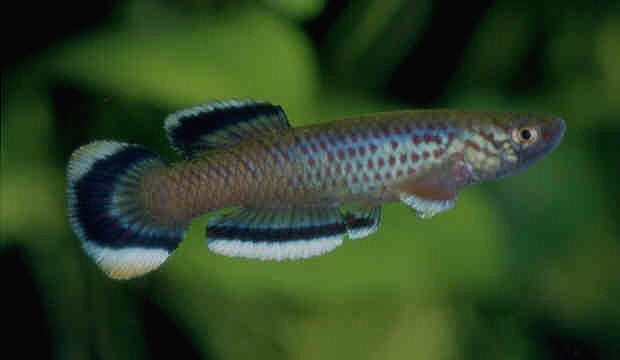Aphyosemion celiae celiae Scheel 1971

Badouma. Photo Courtesy of Ed Pürzl
| Meaning of Name |
After Miss Celia Epie of Meanja, West Cameroon. She is the eldest daughter of John Epie, manager of the Meanja Rubber Estate. | ||||||||||
| First Description |
Scheel J.J. 1971. Aphyosemion franzwerneri & Aphyosemion celiae, two new Rivulins from Cameroon. Tropical Fish Hobbyist magazine 19 (5): p52-61. | ||||||||||
| Size |
5 cm. Wild males are reported to reach 7.5 cm. | ||||||||||
| Meristics |
| ||||||||||
| Karyotype |
n = 10, A = 20. (Scheel 1971, 1974) | ||||||||||
| Sub-Genus |
Mesoaphyosemion | ||||||||||
| Group |
calliurum | ||||||||||
| Synonyms |
| ||||||||||
Populations
A.aff.celiae
Ref: KCF website |
Badouma - Collected in 1973 in the Modiba River (Baduma water) 4 km to the south of Baduma on the road to Kumba. Makandje Plantation (Ladouma), ABK 07/146
- This is a curious population which was distributed as A.calliurum.
I had material from Anita Persson who informed me that JF Agnèse
(the collector) looked at the DNA & considered they should be celiae.
| ||||||||||
| Type Locality |
Small brook close to John Epie's house, Mambanda which is close to Kumba, western Cameroon. | ||||||||||
| Distribution |
Central Mungo drainage system south from Badouma, south west Cameroon. Scheel measured a pH 6.8 - 7.0, TH (Hardness) 7. Blair recorded (January 1969) pH 6.6 - 7.0, TH 0 - 6, air temperature (?) 24 - 26'C. | ||||||||||
| Habitat |
Rainforest brooks & streams near Kumba, western
Cameroon, also secondary savannah. Source: 24°C pH 6·2, DH 0 In March 2 brooks measured north of Mambanda
24°C pH 6·8, - 7, DH 4. Sympatric sp. include Epiplatys sexfasciatus & Procatopus similis (Mambanda). | ||||||||||
| Distinguishing Characteristics |
Caudal fin which has an outer marginal crescent all round of yellow with a dark brown sub marginal band sometimes seperated with a band of white.A.celiae winifredae has a wider yellow crescent. The only sp. A.celiae can be confused with is Fundulopanchax cinnamomeum which is a good deal heavier in the body. The
K1 & K2 forms imported in 1971 were found to produce more colourful offspring
reportedly in 3 variants.
| ||||||||||
| Colour/Pattern Variability | Fairly low. See above. | ||||||||||
| History |
Clausen & Scheel collected in Cameroon in
1968 & found a fish resembling 'cinnamomeum.
These were found in an area south of the then known range of 'cinnamomeum
4 miles north of Kumba. J.J.Scheel described this sp. in the TFH magazine of January 1971. Prior to this date the BKA imported them from a wild shipment sent from Cameroon by David Blair. These were then named 'K1' & 'K2'.
|
||||||||||
| Breeding Notes |
A fairly easy species to breed. Tanks should be shaded. Eggs are laid in top & bottom mops & take 17-22 days of water incubation. Growth is fairly quick with maturity taking around 5 months. Peat fibre can also be used as a spawning medium which can be taken out with the eggs & semi-dry incubated for 3-4 weeks. When they first appeared in the BKA during 1971 it was noted that they spawned in a set up with half an inch of peat on the base, water temperature 73°F, DH 2, pH 6·7. Eggs were laid in floating or partially submerged mops. Eggs were numerous & they could be left in the adults tank. Water incubation period was 12-14 days (also given as 13-15 days in newsletter No.64). It was reported that the sp. lays resting eggs in the ratio of 3 to 1. Fry were large on hatching but growth was slow with colouration not showing through until they reached about one and a half inches. Frequent water changes were advised as the fry seemed susceptible to a build up of bacteria (probably nitrites were the cause of the problem). A report in BKA Newsletter No. 312, Sept. 1991
by Frank Cochrane suggests the best way to breed this sp. is to leave
them alone in a well planted tank. Adults do not seem to molest the
young if fed well. Adding newly hatched brine shrimp to the tank can
be taken by the adults & young. Jim Gasior in BKA Newsletter No.382 July 1997 bred them in water of pH 7·6, DH 10. It was found that times between 50% water changes of longer than 2 weeks resulted in poor fish colour & reduced egg production. Slow growth rate with sexing out at 4-5 months. | ||||||||||
| Diameter of Egg | 1.3mm. | ||||||||||
| Remarks |
This sp. is an expert jumper & will escape
from the smallest of cracks in the cover glass. |